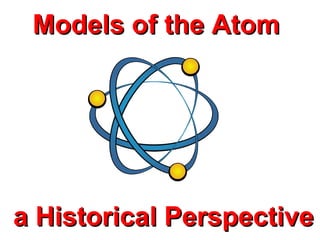
Atomic models
- 1. Models of the Atom a Historical Perspective
- 2. Early Greek Theories Democritus • 400 B.C. - Democritus thought matter could not be divided indefinitely. • This led to the idea of atoms in a void. fire earth Aristotle air water • 350 B.C - Aristotle modified an earlier theory that matter was made of four “elements”: earth, fire, water, air. • Aristotle was wrong. However, his theory persisted for 2000 years.
- 3. John Dalton • 1800 -Dalton proposed a modern atomic model based on experimentation not on pure reason. • All matter is made of atoms. • Atoms of an element are identical. • Each element has different atoms. • Atoms of different elements combine in constant ratios to form compounds. • Atoms are rearranged in reactions. • His ideas account for the law of conservation of mass (atoms are neither created nor destroyed) and the law of constant composition (elements combine in fixed ratios).
- 4. Adding Electrons to the Model Materials, when rubbed, can develop a charge difference. This electricity is called “cathode rays” when passed through an evacuated tube (demos). These rays have a small mass and are negative. Thompson noted that these negative subatomic particles were a fundamental part of all atoms. 1) Dalton’s “Billiard ball” model (1800-1900) Atoms are solid and indivisible. 2) Thompson “Plum pudding” model (1900) Negative electrons in a positive 3) framework. The Rutherford model (around 1910) Atoms are mostly empty space. Negative electrons orbit a positive
- 5. Ernest Rutherford (movie: 10 min.) • Rutherford shot alpha (α) particles at gold foil. Zinc sulfide screen Lead block Thin gold foil Radioactive substance path of invisible α-particles Most particles passed through. So, atoms are mostly empty. Some positive α-particles deflected or bounced back! Thus, a “nucleus” is positive & holds most of an atom’s mass.
- 6. Bohr’s model • Electrons orbit the nucleus in “shells” •Electrons can be bumped up to a higher shell i hit by an electron or a photon of light. There are 2 types of spectra: continuous spectra & line spectra. It’s when electrons fall back down that they release a photon. These jumps down from “shell” to “shell” account for the line spectra seen in gas discharge tubes (through spectroscopes).
- 7. Atomic numbers, Mass numbers • There are 3 types of subatomic particles. We already know about electrons (e–) & protons (p+). Neutrons (n0) were also shown to exist (1930s). • They have: no charge, a mass similar to protons 16 • Elements are often symbolized with their mass E.g. Oxygen: 8 O number and atomic number • These values are given on the periodic table. • For now, round the mass # to a whole number. • These numbers tell you a lot about atoms. # of protons = # of electrons = atomic number # of neutrons = mass number – atomic number • Calculate # of e–, n0, p+ for Ca, Ar, and Br.
- 9. Bohr - Rutherford diagrams • Putting all this together, we get B-R diagrams • To draw them you must know the # of protons, neutrons, and electrons (2,8,8,2 filling order) • Draw protons (p+), (n0) in circle (i.e. “nucleus”) • Draw electrons around in shells He Li Li shorthand 2p 2 n0 + 3 p+ 4 n0 3 p+ 4 n0 2e– 1e– Draw Be, B, Al and shorthand diagrams for O, Na
- 10. Be B 4 p+ 5 n° O Al 5 p+ 6 n° 13 p+ 14 n° Na 8 p+ 2e– 6e– 8 n° 11 p+ 2e– 8e– 1e– 12 n°
- 11. Isotopes and Radioisotopes • Atoms of the same element that have different numbers of neutrons are called isotopes. • Due to isotopes, mass #s are not round #s. • Li (6.9) is made up of both 6Li and 7Li. • Often, at least one isotope is unstable. • It breaks down, releasing radioactivity. • These types of isotopes are called radioisotopes Q- Sometimes an isotope is written without its atomic number - e.g. 35S (or S-35). Why? Q- Draw B-R diagrams for the two Li isotopes. A- The atomic # of an element doesn’t change Although the number of neutrons can vary,
- 12. 6 Li 7 3 p+ 3 n0 2e– 1e– Li 3 p+ 4 n0 2e– 1e– For more lessons, visit www.chalkbored.com
